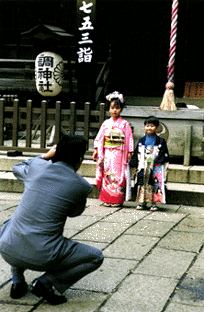ANNUAL CALENDAR November |
|
Shichi-go-san
|
 November 15 is Shichi-go-san, a day of prayer for the healthy growth of young children. Shichi-go-san literally means seven, five, three; in most regions around the country, boys and girls aged three, boys aged five, and girls aged seven visit a Shinto shrine with their parents. Most girls wear kimonos when making their Shichi-go-san visit, while boys don haori jackets and hakama trousers. In recent years, though, an increasing number of children are wearing Western-style dresses and suits.
November 15 is Shichi-go-san, a day of prayer for the healthy growth of young children. Shichi-go-san literally means seven, five, three; in most regions around the country, boys and girls aged three, boys aged five, and girls aged seven visit a Shinto shrine with their parents. Most girls wear kimonos when making their Shichi-go-san visit, while boys don haori jackets and hakama trousers. In recent years, though, an increasing number of children are wearing Western-style dresses and suits.
In medieval times, aristocratic and samurai families celebrated the growth of infants into healthy boys and girls in the following ways.
 Following the visit, parents generally buy chitose-ame (longevity candy) for the children. The candy is shaped like a stick and comes in a bag that carries illustrations of cranes and turtles--two animals that are symbols of long life. Chitose literally means a thousand years and is used to denote very long periods of time. The candy and the bag are both expressions of parents' wish that their children lead long, prosperous lives.
Following the visit, parents generally buy chitose-ame (longevity candy) for the children. The candy is shaped like a stick and comes in a bag that carries illustrations of cranes and turtles--two animals that are symbols of long life. Chitose literally means a thousand years and is used to denote very long periods of time. The candy and the bag are both expressions of parents' wish that their children lead long, prosperous lives.
One of the most popular Shichi-go-san destinations in Tokyo is Hie Shrine in Akasaka. It has been frequented by many families celebrating Shichi-go-san since the Edo period, and today it is visited by around 2,000 families every year.
Photos: Children wear their finest formal clothes (Kyodo); parents take their kids to shrines on this lucky day. (Tokyo Metropolitan Government) |
APR | MAY | JUN | JUL | AUG | SEP | OCT | NOV | DEC | JAN | FEB | MAR |
 |